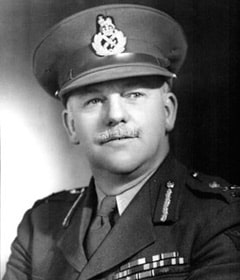One of The Royal Regiment’s brilliant technical proponents, Major-General Harold Oswald Neville Brownfield, was born in Englewood, New Jersey, in December 1894. He was educated in Kingston, Ontario, and subsequently attended the Royal Military College. After graduation, in 1910, he became an instructor with The Royal Canadian Horse Artillery and The Royal School of Artillery in Kingston.
As a Lieutenant, he served in France from 1916 until the armistice. He was awarded the Military Cross for gallantry and noted in his citation, the coolness and courage he displayed while directing the care of the wounded under high explosive and gas barrage while maintaining an observation post under constant machine gunfire. “Brownie,” as he was affectionately known, was mentioned frequently for his skill and courage when it mattered.
After serving in Kingston and Winnipeg, he was nominated to attend the Imperial Staff College. After graduation, in 1934, he was appointed Professor of Tactics at the Royal Military College. At the outbreak of the Second World War, he was a General Staff Officer at Military District Number 7 in Saint John, New Brunswick. He proceeded overseas as Brigade Major, Royal Artillery, 1st Canadian Infantry Division. Promotion soon followed and with it the appointment to command the 8th Field Regiment.
Due to his proven abilities and his experience overseas, he returned to Canada in 1940. He was promoted to fill the Commander Royal Artillery appointment in the newly formed 3rd Division. The following summer, he sailed with the Division for the United Kingdom.
In November 1941, he was appointed Commander Corps, Royal Artillery, at the 1st Canadian Corps. He served both in England and in Italy, before assuming the appointment of Brigadier, Royal Artillery of the First Canadian Army, from November 1943 until January 1945. In the latter stages of the war, he commanded “C” Group, the artillery component of the Canadian Reinforcement Units in the United Kingdom. His work in coordinating all artillery matters was widely acclaimed. His dedication, efficiency, and forceful, positive personality, became his hallmark. Among his many achievements, the conception and establishment of the Canadian Army School of Artillery (Overseas), the development and fielding of the Land Service Mattress (1 Canadian Rocket Battery) and the training of the artillery units supporting Operation OVERLORD. He received the Commander of The Most Excellent Order of the British Empire.
Returning to Canada in 1945, he commanded Prairie Command. One year later, he was appointed Commander Canadian Joint Staff in Washington and promoted to Major-General. He retired in 1947.
He honoured The Royal Regiment, by accepting the position of Colonel Commandant, in 1948. He served The Royal Regiment in this capacity for ten years. During his tenure, he visited most Canadian Gunner units, making many gifts of Regimental plates and trophies. They said he knew more Canadian gunners than any other artillery officer.
His long career was characterized by professionalism, innovative ideas and a genuine feeling for the men of The Royal Regiment. In no small measure, he is responsible for the accomplishments of Canada’s modern gunners.
He died in Brockville, Ontario, on 8 July 1958.

